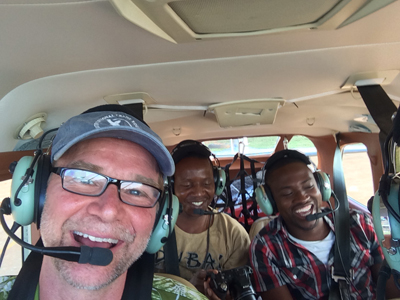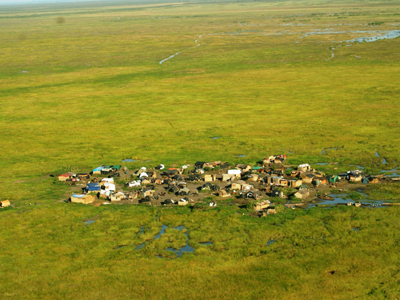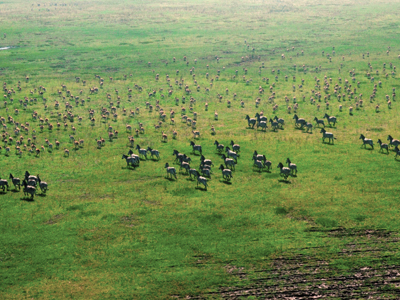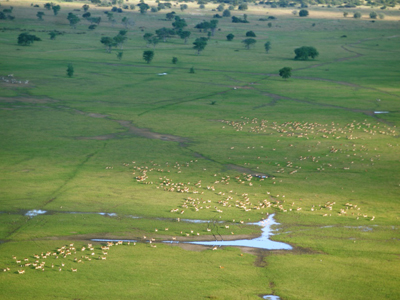What a sight! Recent aerial surveys over the Kafue Flats in Zambia identified
record numbers of Wattled Cranes, including this flock of 400 birds.
By Rich Beilfuss, ICF President & CEO

Great news from Zambia! We just completed 29 hours of intensive aerial surveys over the Kafue Flats, and our preliminary estimate of the number of Wattled Cranes is more than 2,300 – the largest population of Wattled Cranes in the world and the highest count anywhere since the 1980s!
Over 80% of the world’s Endangered Wattled Crane population are found on five large floodplains in southern Africa, and the species’ future is linked to the health of these dynamic ecosystems. Changes in floodplain water cycles from dams, the introduction of invasive species that choke out natural wetlands and displace native plants and animals, and human development all upset the delicate balance needed by Wattled Cranes and other wildlife. Fortunately, the results of our aerial survey give us hope that it is not too late to protect these last strongholds for Wattled Cranes.
Our survey was a partnership between the International Crane Foundation, Zambia Wildlife Authority, and World Wildlife Fund-Zambia. Along with Griffin Shanungu, our Zambia Program Manager, I served as cockpit navigator, data recorder, and spotter during all the flights (right). Packed tightly into our tiny Cessna 208 for five days, we flew 81 transects back and forth across the plains at 100 mph, about 300 feet above the ground. This was the 5th time I have flown aerial surveys of the flats, but I never tire of flying across these life-teeming floodplains.

We counted and mapped all large mammals and waterbirds on the flats, and recorded all evidence of human activity in the park, including settlements, fishing camps (above), incidents of burning or logging, and counts of all livestock, especially cattle, which number in the hundreds of thousands.
Our biggest news was the Wattled Cranes. The Kafue Flats is home to the highest counts ever recorded for the species (more than 3,000 in the 1970s), but there was strong evidence of decline during the past 25 years. During our survey, however, we observed 920 Wattled Cranes on the floodplain, including one huge flock of more than 400 birds. Because this was a sample survey (covering about 15% of the plains) our actual population estimate is much higher, and our preliminary estimate suggests a population of more than 2,300 birds.

Kafue Flats is renowned as a bird paradise, and the wetland teems with waterbirds – we counted thousands of Spurwing geese and African openbill storks, and recorded more than 40 species of wetland birds overall. The flats also are the only place in the world where the Kafue lechwe occurs, a wetland-dependent antelope that grazes down vast areas of floodplain grasses as annual floodwaters recede, creating excellent foraging habitat for Wattled Cranes. Although we counted many thousands of lechwe on the floodplain, we are concerned that this rare species is in decline across the flats and it will be an important focus of our conservation efforts. Other important mammals we observed include many hundreds of zebra, a herd of 150 Africa buffalo, and smaller numbers of hippo, wildebeest, reedbuck, and deep marsh-dwelling sitatunga.

Wattled Cranes are challenging to study on these immense floodplains, and we are still learning why the species is increasing in places, and decreasing elsewhere. My theory is that as human populations grow across Africa and smaller wetlands are drained, converted to agriculture, or disturbed by people and livestock, large floodplain systems like the Kafue Flats are increasingly vital to Wattled Crane survival. This means that our efforts to protect these floodplains for Wattled Cranes and many other species has never been more important!
Support our work to protect the Kafue Flats and other wetlands critical to cranes throughout the world by donating to the International Crane Foundation.
